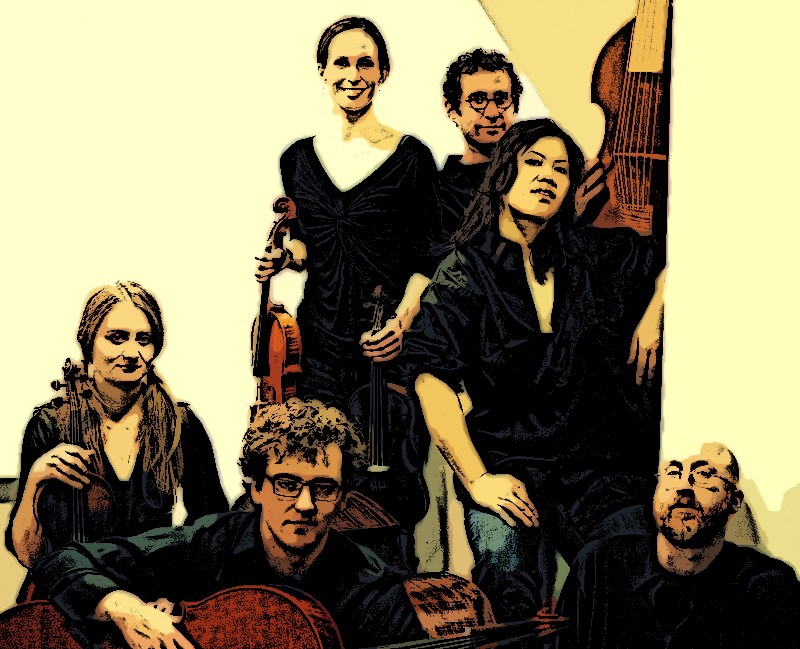With wine and song, The Colonials bring a new paradigm to new music
What’s the point of intermission? Carved out of the arbitrary protocols of concert-going, the intermission masquerades as a pause that refreshes, a chance to share drinks, snacks and talk with one’s companions and complete strangers. But in practice there’s almost never enough time to actually buy a drink, much less consume it.
Attending a concert is not just a ceremonial genuflection toward Apollo, but a social activity, to which most concert programs give little room.
And it is the embrace of the historical social aspect that made Tuesday evening’s season ending concert by the chamber ensemble The Colonials so enjoyable. That, and the music, of course.
The Colonials are violinist Elizabeth Derham, cellist Paul Dwyer, violist Kristina Giles, bassist Doug Balliett, and pianist Alexandria Le. The concert, at the Louis K. Meisel Gallery in Soho, was part of their “Literature Project” involving music and writing.
The Colonials describe themselves as specialists in historically informed performance practice, the classical repertoire, and new music, which is a long and odd way of saying that they play music in the Western classical tradition. All the music they played was new. That’s an important point: as different and au courant as it may seem to hold a concert of new music in an art gallery—and serve wine and hors d’ouevres—the setting was close to how Schubert’s “Trout” Quintet (the group’s instrumental model) was heard when it premiered, 200 years ago.
The three sets of pieces were all based on literature, from Marc LeMay’s Quintet, inspired by Wallace Stevens, to vocal settings of Elizabethan poetry and T.S. Eliot, composed by Balliett, and Jessica Meyer’s Seasons of Basho, using four haiku by the great master of the form. Quintet was purely instrumental, the other works were sung by countertenor Eric Brenner.
LeMay’s piece was in two parts—one fast and one slow—that responded to two stanzas of Steven’s poem “Six Significant Landscapes.” His musical language is pleasingly muscular and upfront. The first section bursts open with ringing sonorities and rhythmic vitality, and moments of polytonality, that had the vibrant sound of mid–20th century American music. The main feature of the second section was a bass melody that Balliett had asked the composer to write. Amidst a quiet and still background, Balliett’s solo line sung in the instrument’s upper register, before descending gracefully to a plangent cadence. The piece built up an overall expressive symmetry, with a passionate lyricism wrapping up the opening verve.
For his own compositions, Balliett put down the contrabass and briefly picked up the bass viola da gamba. His small handful of songs had no overriding concept; the first two came from The Passionate Pilgrim, an early Shakespearian fraud, the last set from Eliot’s “His Soul Stretched Tight.”
Balliett plucked the gamba to accompany Brenner in the first song, “Live With Me and Be My Love,” which produced a marvelous quality, channeling Joni Mitchell by way of John Dowland. But the addition of the rest of the musicians forced the song into a too-neat pop form. The second song, “Beauty Is,” was much more flowing and expressive, the line more determined by meaning rather than a sense of order, and the Eliot setting was excellent. The commission called for the use of electronics, and Marcus Rubio produced a bland, irrelevant background, but the composing itself was excellent. Brenner clearly relished the descending and rising arcs of the vocal line, and the piano trio accompaniment was gently supportive.
Meyer is a talented composer, and though her settings were uneven, they had the overall strength of reaching for something new and unknown. Brenner was accompanied by cello and piano, and the music and vocal setting captured some of the existential loneliness at the core of the poems. Meyer’s writing for the cello was idiomatic, imaginative, and with a sense of freedom, but the piano music tended toward the stodgy. The piece is nicely shaped, though, with a sense of drama and emotional involvement building step by step, until Winter arrives with substantial weight, Brenner singing long lines that sought a far horizon.
The final main performer didn’t pick up an instrument or write a note, he was sommelier Étienne Guérin, who paired wines with each of the three sets of pieces. The success of his own thematic idea—that, for music yet to be heard, he chose wines he himself had not tasted—was an intensely subjective judgment, depending on how closely one can equate the senses of taste and hearing. But it was stimulating to hear him explain why he chose each wine, part of the connection between audience and performers and the social context that was so involving.
Drinking wine doesn’t necessarily make for better music, but drinking wine and chatting with musicians between sets made for a convivial and involved audience, invested in the mutual experience. Discarding the dutiful rituals of the concert hall was pleasurable, and weaving music into the fabric of social life made the art that much more meaningful.







